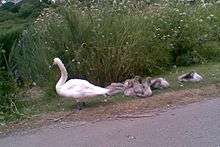Swanpool, Cornwall
Swanpool (Cornish: Lynyeyn Pryskelow, meaning cold pool of the elm thicket) is a small coastal saline lagoon with a shingle bar, separating it from the beach of the same name. The South West Coast Path crosses the bar. The pool is near the town of Falmouth, on the south coast of Cornwall, England, UK, between Maenporth and Gyllyngvase. A notable building in the area is Swanpool House, a 19th-century building which was occupied by American forces during the Second World War but is now in use as holiday apartments. There was formerly a mine extending beneath the lagoon.[1]

Natural history
Coastal saline lagoons are water bodies that are fed by saline water, in this case from the adjacent sea of Falmouth Bay, either by percolation through the bar, or, by restricted inlets such as a sluice. Swanpool also receives freshwater from a small stream and from rainfall. The water of Swanpool has permanent vertical stratification with variation in the salinity with depth.[2]

The pool is a Local Nature Reserve,[3][4][5] and a Site of Special Scientific Interest.[6][7] It is of scientific importance as it is one of the few locations that has the perfect salinity for the growth of the trembling sea mat (Victorella pavida), a bryozoan.[8] Some other species of fauna and flora at Swanpool are:
- mallard duck
- moorhen
- mute swan
- coot
- water rail
- kingfisher
- little grebe
- siskin
- tufted duck
- lady's smock or cuckoo flower
- yellow flag iris
Swanvale nature reserve
There is also a small Cornwall Wildlife Trust nature reserve called Swanvale which runs from the northern end of Swanpool towards the town. It comprises mostly willow carr, which provides shelter for many small birds and mammals.
Swanpool mine
Swanpool mine is 80 fathoms (480 ft; 150 m) deep and produced £60,000 worth of silver-lead ore. It started in the early 18th century, closing in 1865 and recommenced on 22 November 1880, financed by Sir Julius Vogel and his friends.[1][9]
Visitor facilities
Swanpool Beach is a training ground for kayaking, paddleboarding and coasteering run by of Elemental Watersports, with a beach café, a popular beach restaurant, Hooked (formerly the Three Mackerels Restaurant), car-parking (charge in summer), a public lavatory and crazy golf. Dogs are not allowed on the beach between Easter Sunday and 1 October.
References
- "Swanpool Mine". Mindat.org. Retrieved 29 June 2017.
- Bamber, R N (2010). "Coastal saline lagoons and the Water Framework Directive". Natural England Commissioned Report NECR039. Natural England. Retrieved 16 August 2013.
- Swanpool Local Nature Reserve website
- "Swanpool". Local Nature Reserves. Natural England. Retrieved 1 August 2013.
- "Map of Swanpool". Local Nature Reserves. Natural England. Retrieved 1 August 2013.
- "Swanpool" (PDF). Natural England. 1995. Retrieved 28 October 2011.
- Gainey, P. A. (1997). "Trembling sea-mat: baseline distribution in England and species action plan (Introduction)". English Nature Research Reports, No. 225. Downey, A. J.;Tonkin, B. English Nature: 1. ISSN 0967-876X. Cite journal requires
|journal=(help) - Marine life information network website: Victorella pavida
- "Falmouth". The Cornishman (124). 25 November 1880. p. 5.
External links
| Wikimedia Commons has media related to Swanpool, Falmouth. |